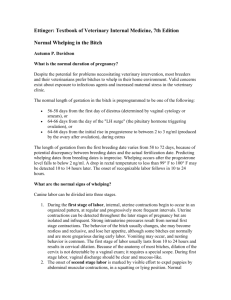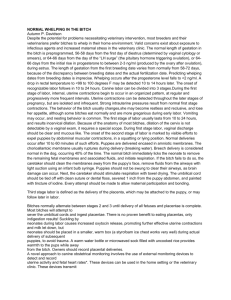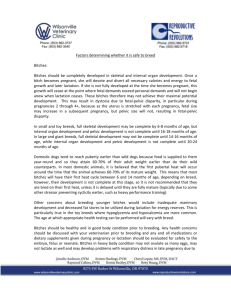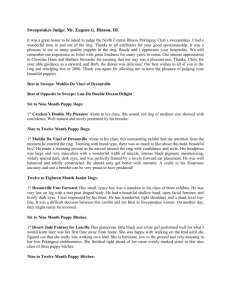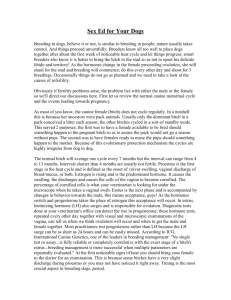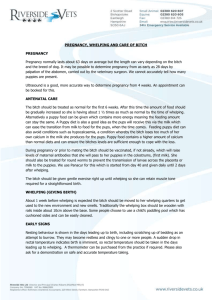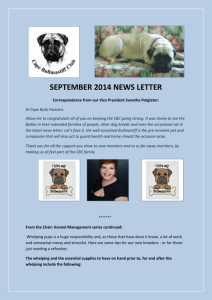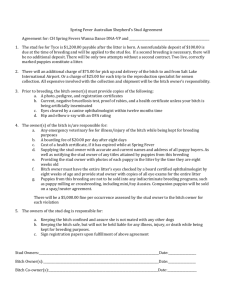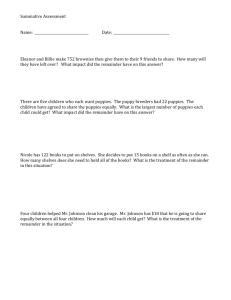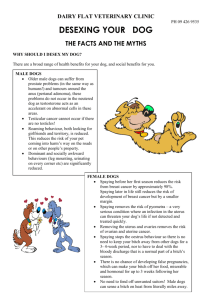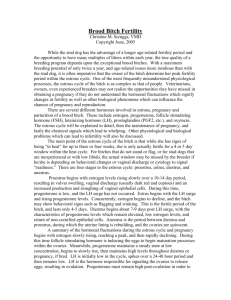Recommendations for Breeding and Pregnant Bitches
advertisement
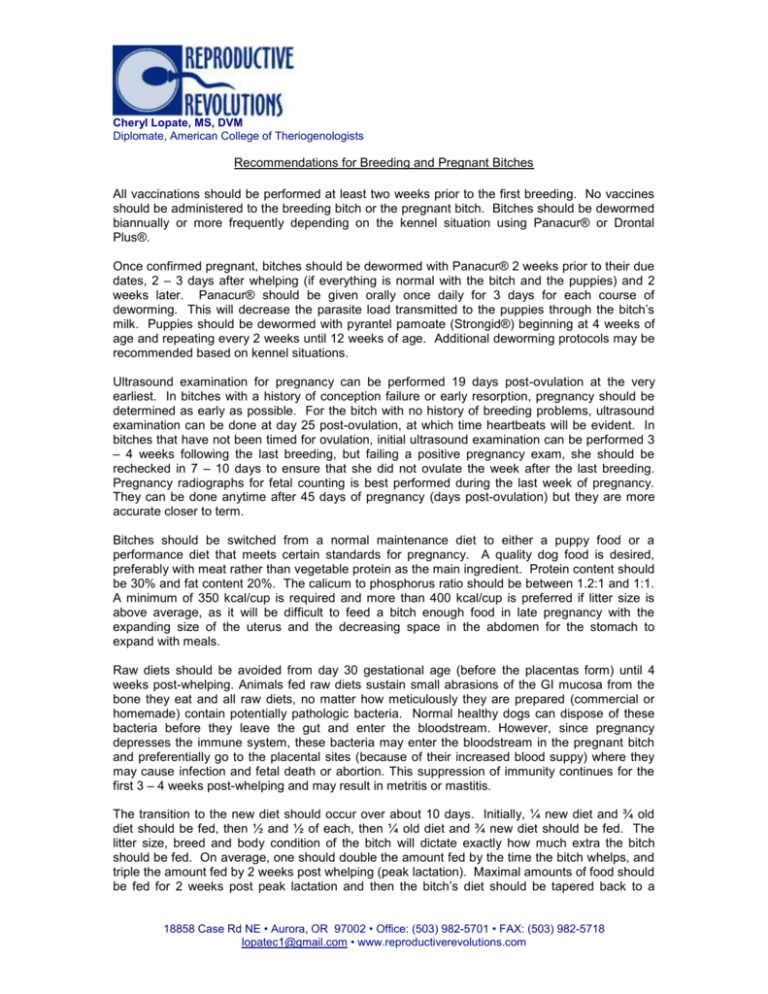
Cheryl Lopate, MS, DVM Diplomate, American College of Theriogenologists Recommendations for Breeding and Pregnant Bitches All vaccinations should be performed at least two weeks prior to the first breeding. No vaccines should be administered to the breeding bitch or the pregnant bitch. Bitches should be dewormed biannually or more frequently depending on the kennel situation using Panacur® or Drontal Plus®. Once confirmed pregnant, bitches should be dewormed with Panacur® 2 weeks prior to their due dates, 2 – 3 days after whelping (if everything is normal with the bitch and the puppies) and 2 weeks later. Panacur® should be given orally once daily for 3 days for each course of deworming. This will decrease the parasite load transmitted to the puppies through the bitch’s milk. Puppies should be dewormed with pyrantel pamoate (Strongid®) beginning at 4 weeks of age and repeating every 2 weeks until 12 weeks of age. Additional deworming protocols may be recommended based on kennel situations. Ultrasound examination for pregnancy can be performed 19 days post-ovulation at the very earliest. In bitches with a history of conception failure or early resorption, pregnancy should be determined as early as possible. For the bitch with no history of breeding problems, ultrasound examination can be done at day 25 post-ovulation, at which time heartbeats will be evident. In bitches that have not been timed for ovulation, initial ultrasound examination can be performed 3 – 4 weeks following the last breeding, but failing a positive pregnancy exam, she should be rechecked in 7 – 10 days to ensure that she did not ovulate the week after the last breeding. Pregnancy radiographs for fetal counting is best performed during the last week of pregnancy. They can be done anytime after 45 days of pregnancy (days post-ovulation) but they are more accurate closer to term. Bitches should be switched from a normal maintenance diet to either a puppy food or a performance diet that meets certain standards for pregnancy. A quality dog food is desired, preferably with meat rather than vegetable protein as the main ingredient. Protein content should be 30% and fat content 20%. The calicum to phosphorus ratio should be between 1.2:1 and 1:1. A minimum of 350 kcal/cup is required and more than 400 kcal/cup is preferred if litter size is above average, as it will be difficult to feed a bitch enough food in late pregnancy with the expanding size of the uterus and the decreasing space in the abdomen for the stomach to expand with meals. Raw diets should be avoided from day 30 gestational age (before the placentas form) until 4 weeks post-whelping. Animals fed raw diets sustain small abrasions of the GI mucosa from the bone they eat and all raw diets, no matter how meticulously they are prepared (commercial or homemade) contain potentially pathologic bacteria. Normal healthy dogs can dispose of these bacteria before they leave the gut and enter the bloodstream. However, since pregnancy depresses the immune system, these bacteria may enter the bloodstream in the pregnant bitch and preferentially go to the placental sites (because of their increased blood suppy) where they may cause infection and fetal death or abortion. This suppression of immunity continues for the first 3 – 4 weeks post-whelping and may result in metritis or mastitis. The transition to the new diet should occur over about 10 days. Initially, ¼ new diet and ¾ old diet should be fed, then ½ and ½ of each, then ¼ old diet and ¾ new diet should be fed. The litter size, breed and body condition of the bitch will dictate exactly how much extra the bitch should be fed. On average, one should double the amount fed by the time the bitch whelps, and triple the amount fed by 2 weeks post whelping (peak lactation). Maximal amounts of food should be fed for 2 weeks post peak lactation and then the bitch’s diet should be tapered back to a 18858 Case Rd NE • Aurora, OR 97002 • Office: (503) 982-5701 • FAX: (503) 982-5718 lopatec1@gmail.com • www.reproductiverevolutions.com Cheryl Lopate, MS, DVM Diplomate, American College of Theriogenologists normal amount (beginning at the time that food is first beginning to be supplemented to the puppies) and should be back to a normal amount by the time of weaning. She should be transitioned back onto her regular adult dog food over 10 days as well, using the same type of transition schedule as described above. Exact amounts of food should be determined following discussion with the veterinarian after considering litter size and body condition of the bitch. The bitch’s temperature should be taken 3 times daily beginning 1 week before her due date. Temperatures should be taken at the same time each day with no more than 8 hours between monitoring. A drop in temperature below 98F is indicative of whelping within the next 24 – 36 hours. In some bitches the temperature drop does not reliably occur or may be more subtle and only reach 99°F (small litters of 1 – 2 puppies or in bitches where progesterone does not fall below 2 ng/ml before whelping). Breeders need to contact their veterinarian under the following conditions: 1) Pregnancy length longer than 67 days from the LH surge, 65 days from ovulation, 60 days from day 1 of diestrus or more than 72 days from the last breeding 2) More than 4 hours between rupture of the first water sac and delivery of the first puppy 3) More than 30 minutes of hard straining without delivery of a puppy 4) More than 2 hours between delivery of puppies 5) Any green-black discharge prior to delivery of the first fetus by more than 1 – 2 hours or increasing/large amounts of green-black discharge without signs of uterine contractions 6) Any significant frank bloody discharge at any point during delivery 7) Bitches that have acute abdominal pain, collapse or shock-like signs at term or during labor Bitches should be checked daily for mastitis beginning a day or two before whelping and continuing through the first 3 weeks of lactation. Any firm, painful, reddened glands should be carefully monitored. Additionally, any abnormal color or blood in the milk, should receive veterinary attention. Any change in the bitch’s attitude or appetite should be considered a potential signs of post-partum disease. Temperature should be monitored twice daily the first week post-whelping, and any elevations above 103°F require consultation with a veterinarian. Any odor to or excessive amounts of vulvar discharge, should instigate veterinary attention. Any change in the normal color of the post-whelping discharge (dark red and mucus like in consistency) to dark brown, brown, or green should be seen by a veterinarian. Any trembling, muscle twitching, rigidity, or excessive facial itching requires immediate veterinary attention. Bitches can be very picky eaters during the first week post-whelping, but should be eating something and should remain interested in the puppies. Any signs of depression, disinterest in the puppies, or detachment should instigate an examination. Puppies that constantly nurse or cry indicate a problem either with the puppies or with the bitch. Puppies should nurse frequently (hourly) but then have activated sleep (twitching) in between nursing. Puppies that nurse constantly are probably not getting adequate milk. Puppies should gain 10 – 15% of their body weight daily (from day 2 onward – usually lose weight the first day) for the first 2 weeks. Puppies that cry, whine, are bloated, separate themselves from the rest of the litter, do not have activated sleep, develop diarrhea or irregular respiratory problems, develop skin infections, or have red, swollen umbilical stumps should have immediate veterinary attention. 18858 Case Rd NE • Aurora, OR 97002 • Office: (503) 982-5701 • FAX: (503) 982-5718 lopatec1@gmail.com • www.reproductiverevolutions.com
